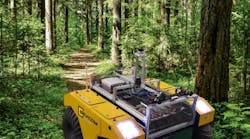When two robots arrive at the same goal on the battlefield, which one fulfills the mission? Fortunately, U.S. Army researchers have developed a technique they call α-shape to settle multiple-robot goal competitions, especially in situations where autonomous systems may lose communications with each other. The method was developed by the U.S. Army Combat Capabilities Development Command (DEVCOM), the U.S. Army Research Laboratory, and the University of Nebraska, Omaha Computer Science Department.
“Robots working in teams need a method to ensure that they do not duplicate effort,” said Army researcher Dr. Bradley Woosley. “When all robots can communicate, there are many techniques that can be used; however, in environments where the robots cannot communicate widely due to needing to stay covert, clutter leading to radios not working for long-distance communications, or to preserve battery or bandwidth for more important messages, the robots will need a method to coordinate with as few communications as possible.”
All possible operating scenarios must be considered on the battleground even when communications and networking between robots and human operators is not possible, perhaps by robot-to-robot communications. By sharing information with select members of a team, robots can determine which robot handles which task. As part of the α-shape technique, robots in the field are assigned different bounding shapes for an operating environment and different sets of goals for each bounding area. The α-shape technique uses geometry-based predictions to provide an efficient method for resolving goal conflicts between multiple robots that may want to visit the same area during missions including unmanned search and rescue, robotic reconnaissance, perimeter surveillance, and robotic detection of physical phenomena, such as radiation and underwater concentration of lifeforms.
“This research enables coordination between robots when each robot is empowered to make decisions about its next tasks without requiring it to check in with the rest of the team first,” Woosley said. “Allowing the robots to make progress towards what the robots feel is the most important next step while handling any conflicts between two robots as they are discovered when robots move in and out of communications range with each other.”
